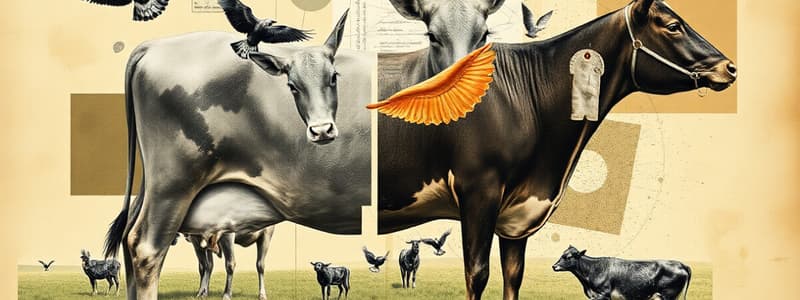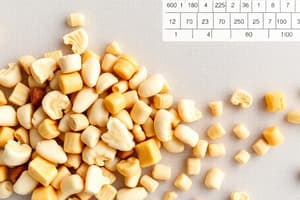Podcast
Questions and Answers
A feed additive that inhibits oxidation in fats, preventing rancidity, is known as an ______.
A feed additive that inhibits oxidation in fats, preventing rancidity, is known as an ______.
antioxidant
Minerals such as calcium, phosphorus, and magnesium, which are needed in relatively large quantities in an animal's body, are classified as ______.
Minerals such as calcium, phosphorus, and magnesium, which are needed in relatively large quantities in an animal's body, are classified as ______.
macrominerals
Animals with a simple, single-compartment stomach, such as swine and poultry, are referred to as ______, and they require dietary starch and amino acids.
Animals with a simple, single-compartment stomach, such as swine and poultry, are referred to as ______, and they require dietary starch and amino acids.
monogastrics
In feed analysis, the estimate of protein content based on the amount of nitrogen present is called ______, but this does not give individual amino acid profiles.
In feed analysis, the estimate of protein content based on the amount of nitrogen present is called ______, but this does not give individual amino acid profiles.
The portion of a feed sample that remains after boiling in weak acid and alkali, primarily consisting of plant structural carbohydrates, is known as ______.
The portion of a feed sample that remains after boiling in weak acid and alkali, primarily consisting of plant structural carbohydrates, is known as ______.
The analysis that determines the total fiber content, including cellulose, hemicellulose, and lignin, is the ______ analysis.
The analysis that determines the total fiber content, including cellulose, hemicellulose, and lignin, is the ______ analysis.
The analysis that measures the least digestible portion of the fiber, which includes cellulose and lignin, is the ______ analysis.
The analysis that measures the least digestible portion of the fiber, which includes cellulose and lignin, is the ______ analysis.
The protective coating on plant tissues that makes cellulose and hemicellulose less accessible to bacterial attack is called ______, which makes it indigestible to livestock.
The protective coating on plant tissues that makes cellulose and hemicellulose less accessible to bacterial attack is called ______, which makes it indigestible to livestock.
The value calculated by subtracting the sum of water, ether extract, crude protein, crude fiber, and ash from the original sample weight is known as ______.
The value calculated by subtracting the sum of water, ether extract, crude protein, crude fiber, and ash from the original sample weight is known as ______.
A digestive system consisting of a multi-compartmental stomach including a forestomach (rumen, reticulum, and omasum) and an abomasum is a ______.
A digestive system consisting of a multi-compartmental stomach including a forestomach (rumen, reticulum, and omasum) and an abomasum is a ______.
Flashcards
Dry Matter (DM)
Dry Matter (DM)
Percentage of feed that is not water.
Ash
Ash
Measure of total mineral content in feed.
Crude Protein (CP)
Crude Protein (CP)
Estimate of protein level based on nitrogen content.
Ether Extract (EE)
Ether Extract (EE)
Signup and view all the flashcards
Crude Fiber (CF)
Crude Fiber (CF)
Signup and view all the flashcards
Neutral Detergent Fiber (NDF)
Neutral Detergent Fiber (NDF)
Signup and view all the flashcards
Acid Detergent Fiber (ADF)
Acid Detergent Fiber (ADF)
Signup and view all the flashcards
Cellulose
Cellulose
Signup and view all the flashcards
Lignin
Lignin
Signup and view all the flashcards
Nitrogen-Free Extract (NFE)
Nitrogen-Free Extract (NFE)
Signup and view all the flashcards
Study Notes
- Livestock are most productive when fed a ration that meets their nutritional needs.
- Laboratory analysis of feeds is the best indicator for predicting animal performance.
- This publication helps livestock producers interpret feed analysis results for ration planning.
- Livestock feed analyses provide data to:
- Determine nutrient content
- Decrease feed costs
- Evaluate forage production practices
- Set and monitor nutrient standards.
- Analysis results are useful when the sample tested represents what the animals eat.
- Poor sampling leads to misleading feed analysis values and economic loss.
Glossary
- Antioxidant: feed additive that inhibits oxidation in fats.
- Macrominerals: minerals found in the animal's body at concentrations greater than 100 ppm, including calcium (Ca), phosphorus (P), magnesium (Mg), potassium (K), chlorine (Cl), sodium (Na), and sulfur (S); and are expressed in percent of dry matter.
- Microminerals: minerals found in an animal's body at concentrations less than 100 ppm, which are copper (Cu), iron (Fe), zinc (Zn), selenium (Se), fluorine (Fl), manganese (Mn), cobalt (Co), iodine (I), molybdenum (Mo), nickel (Ni), and silicon (Si).
- Monogastric: a digestive system consisting of "one stomach," includes humans, swine, poultry, horses, rabbits, dogs, and cats.
- Monogastrics have limited ability to digest fiber and non-protein nitrogen sources.
- Dietary starch and amino acids are essential.
- Ruminant: a digestive system consisting of a multicompartmental stomach, namely a forestomach (rumen, reticulum, and omasum) and an abomasum (true stomach).
- Examples include cattle, sheep, goats, buffalo, and deer.
- Ruminants' ability to digest fiber and use non-protein nitrogen sources is excellent.
- Non-protein nitrogen (NPN): refers to any nitrogen (N) not in the form of amino acids (includes ammonia, ammonium phosphate, urea, and dietary nucleic acids.)
- NPN is most effectively used by ruminants and requires a readily available dietary carbohydrate source.
- True protein: consists of long chains of amino acids linked together; essential for diets of monogastrics.
Feed Component Analysis
- Dry Matter (DM): the percentage of the feed that is not water (moisture).
- Fresh grass has higher moisture and lower DM than hay.
- Ash: total inorganic matter
- Measures the total mineral content in the feed, but not individual minerals.
- Crude Protein (CP): an estimate of the level of protein in the feed based on the amount of nitrogen present.
- Does not reflect true protein content or amino acid profiles.
- Ether Extract (EE): also termed crude fat, it measures the amount of fat and fat-soluble components in a feed.
- Includes plant pigments and fat-soluble vitamins, but not how much of each is present.
- Crude Fiber (CF): the insoluble carbohydrate remaining after boiling the sample in weak acid and alkali.
- Neutral Detergent Fiber (NDF): the percent of total fiber in the feed.
- Plant cell wall components: cellulose, hemicellulose, lignin, silica, insoluble CP, and ash.
- Used with ADF, cellulose, and lignin instead of the older crude fiber analysis.
- Acid Detergent Fiber (ADF): the percent of the least digestible parts of cell walls: cellulose, lignin, silica, insoluble CP, and ash.
- Cellulose: the principal constituent of plant cell walls.
- Lignin: a protective coating on the cellulose-hemicellulose structure of plant tissues.
- Nitrogen-Free Extract (NFE): calculated value of the original sample weight less water, ether extract, crude protein, crude fiber, and ash.
DM Considerations
- DM increases with plant age at harvest.
- Lower DM indicates more moisture content, and lower nutrient density.
- High moisture can decrease the keeping quality, unless made into silage.
Ash Considerations
- Ash is not digestible by animals
- High ash may dilute the concentration of nutrients.
- High ash in plants may indicate soil contamination
CP Considerations
- CP in plants peaks at 4-6 weeks of age.
- Legumes are generally higher in protein than grasses.
- Seed oil meals have higher CP than whole grains.
- Protein quality of grasses declines more rapidly than legumes with plant age.
EE Considerations
- EE is usually higher in meat, fish by-products, and whole seeds.
- High fat content makes feed susceptible to rancidity.
- An antioxidant (Vitamin E) prevents rancidity.
CF Considerations
- CF is the poorly digested component of a feed.
- Consists of plant structural carbohydrates (cellulose and hemicellulose), and some lignin.
NDF Considerations
- NDF increases as plants mature.
- Animal tissues do not contain fiber, but they may contain small amounts of NDF due to ash and other insoluble components.
- NDF influences level of intake.
- High levels limit intake, but minimum levels prevent fattening during pregnancy, and maintain a healthy rumen.
- It stimulates rumination, chewing, and saliva production.
ADF Considerations
- ADF increases as plants mature
- ADF is generally higher in legumes than grasses.
- For a given sample, ADF will be lower than NDF content
- The difference between the two reflects the amount of hemicellulose present.
- ADF reflects a feed's digestibility
- The lower the ADF content, the higher the digestibility.
- Used in calculating energy estimates, such as TDN (total digestible nutrients) or NE (net energy).
Cellulose Considerations
- Cellulose is digested well by ruminants, moderately by horses and rabbits, and poorly by swine.
Lignin Considerations
- Lignin has no known nutritive value, except as a bulk factor.
- At high levels, it reduces digestibility of other nutrients.
NFE Considerations
- The NFE fraction in grain is a nutrient for livestock species, but it is less available in forage.
Studying That Suits You
Use AI to generate personalized quizzes and flashcards to suit your learning preferences.


